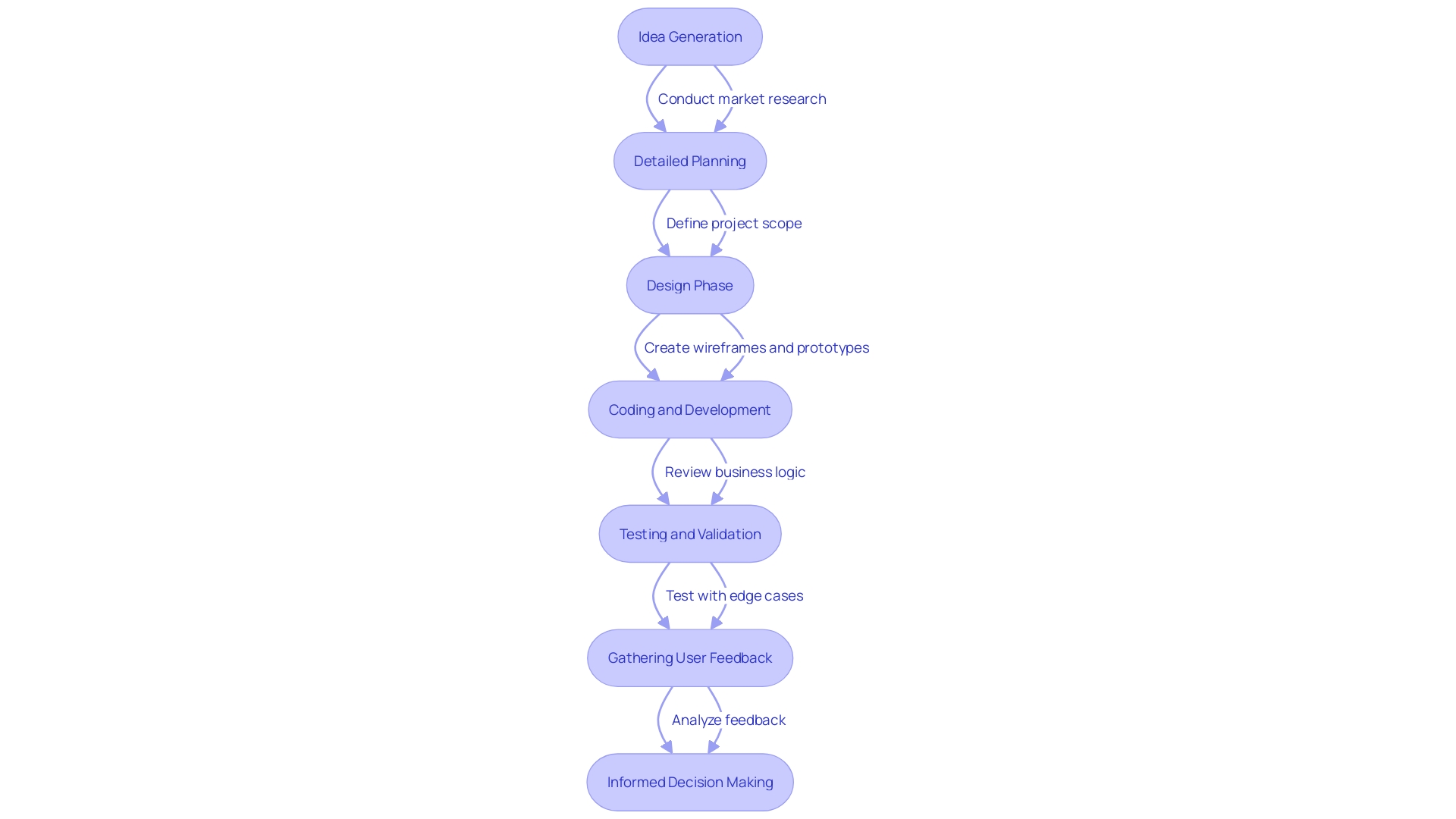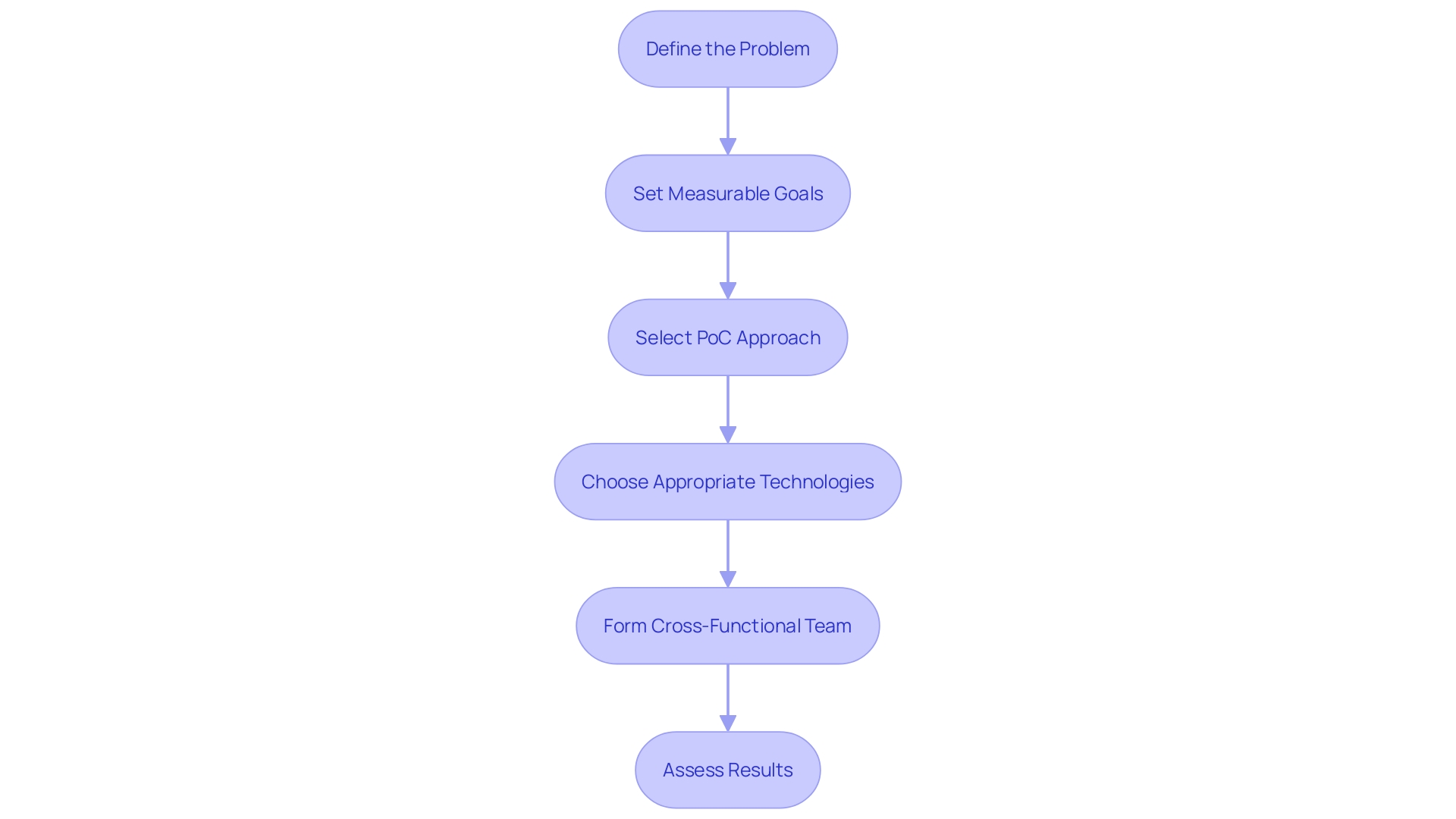Introduction
In the fast-evolving landscape of software development, ensuring the feasibility of a project before committing extensive resources is paramount. This is where the concept of a Proof of Concept (PoC) becomes invaluable. A PoC serves as a preliminary model to validate the functionality and performance of a solution in a controlled environment, addressing potential issues early in the development cycle.
This process not only mitigates risks but also enhances resource allocation and efficiency. By integrating both hardware and software verification, development teams can simulate real-world conditions more accurately, leading to fewer errors and higher quality in the final product. Understanding the significance of a PoC, its necessity, and the steps to create an effective one can profoundly impact the success of software projects.
Additionally, being aware of common pitfalls and strategies to avoid them can further streamline the development process, ensuring a robust and reliable outcome.
What is a Proof of Concept (PoC) in Software Development?
A Proof of Concept (PoC) is essential in the software creation lifecycle as it aids in confirming the viability of a project before dedicating substantial resources. By building a preliminary model or prototype, stakeholders can assess the functionality and performance of the solution in a controlled environment. This method is especially advantageous in handling the intricacy of contemporary systems, where problems associated with hardware and software interaction can be identified early, thus preventing expensive repairs later in the process. Additionally, PoCs help address the challenge of simulating real-world conditions, which traditional methods often fail to replicate accurately. By integrating hardware and software verification processes, project teams can ensure a more thorough and effective evaluation, ultimately leading to higher efficiency and fewer errors in the final product.
Why Do You Need a Proof of Concept in Software Development?
Creating a Proof of Concept (PoC) is a crucial step in software creation, allowing teams to investigate and confirm ideas rapidly and efficiently. 'This approach is particularly beneficial for mitigating risks associated with investment in initiatives.'. By testing and validating concepts early in the development process, resources can be allocated more efficiently, and potential challenges can be identified upfront. This proactive strategy significantly reduces the likelihood of costly mistakes later in the lifecycle.
Jason Fried, co-founder of 37Signals, emphasizes the importance of launching quickly to gather real-world feedback, rather than spending excessive time on pre-launch validation. His perspective highlights the value of getting a product into users' hands to test its viability. In the same way, many successful endeavors that took only a few weeks to code and launch have shown that genuine user interaction often offers the most dependable form of validation.
Moreover, expert findings from various Fortune 500 organizations underline the transformative potential of new technologies, such as Generative AI, in accelerating development speed and enhancing quality. These advancements underscore the need for businesses to remain agile and continuously invest in scaling their quality engineering processes.
In essence, a well-executed PoC not only helps in making informed decisions but also fosters innovation by allowing teams to experiment and adapt quickly based on actual user feedback. This approach aligns with the broader trend of rapid digital transformation, where speed and adaptability are crucial for success.

Key Steps to Create an Effective Proof of Concept
Creating a successful Proof of Concept (PoC) involves several crucial stages. Begin by clearly defining the problem you aim to solve and establishing specific, measurable goals. This clarity ensures everyone involved understands the initiative's direction and objectives. Choose an appropriate PoC approach tailored to your objectives, whether it's a technical validation or a market feasibility study.
Choosing the appropriate technologies and platforms is essential; they must correspond with your requirements and future scalability. Form a skilled, cross-functional team and assign clear roles to leverage diverse expertise. As emphasized by industry experts, “The goal is to identify any potential technical risks and ensure that the technology can support the project’s requirements.”
Finally, assess the results rigorously. Evaluate whether the PoC has successfully demonstrated the concept's feasibility and potential value. This assessment helps avoid significant investments in unviable ideas. Proof of Concepts not only mitigate risks but also provide data-driven insights, ensuring that the final product is well-aligned with market needs and technical capabilities.

Common Pitfalls in Developing a Proof of Concept and How to Avoid Them
When developing a Proof of Concept (PoC), teams often encounter common pitfalls such as scope creep, inadequate testing, and unclear objectives. Scope creep can derail projects if not carefully managed. Maintaining a focused scope aligned with your goals is essential. This approach mirrors modern software delivery methodologies, which emphasize controlling risk through predictability and reducing dependencies between teams. For instance, the construction of the Hoover Dam required meticulous organization to ensure all pieces fit together seamlessly, a principle that applies to PoC development as well.
Insufficient examination is another common problem. Effective evaluation is crucial for validating assumptions and ensuring code quality. By enhancing evaluation processes, fewer breaking changes occur in production. Test scripts and automated evaluations can play a significant role, as they follow a structured process to ensure reliability and performance. As Paul Valderama, a Senior Web & Mobile Developer, highlighted, structured testing environments save time and improve efficiency.
Additionally, unclear goals can lead to misalignment among stakeholders. Ensuring that all stakeholders have a clear understanding of the project's objectives and expected outcomes is vital. This clarity avoids unnecessary rework and aligns efforts towards a common goal.
In summary, to avoid these issues, maintain a focused scope, conduct thorough testing, and ensure clear communication of objectives among all stakeholders.

Conclusion
The Proof of Concept (PoC) serves as an essential tool in the software development lifecycle, validating the feasibility of a project before significant resources are committed. By creating a preliminary model, stakeholders can assess functionality and performance, addressing potential challenges early in the process. This proactive approach not only enhances resource allocation but also mitigates risks associated with complex systems, ensuring a more efficient path to development.
Developing a PoC is vital for exploring and validating ideas swiftly, allowing teams to allocate resources effectively and identify challenges upfront. Emphasizing the importance of real-world feedback, successful projects demonstrate that quick launches can lead to valuable insights. The integration of emerging technologies accelerates development speeds, highlighting the necessity for businesses to remain agile and responsive to user needs.
Creating an effective PoC requires clear problem definition, careful selection of technologies, and a skilled, cross-functional team. Rigorous assessment of results ensures that the concept's viability is validated, preventing costly investments in unfeasible ideas. Awareness of common pitfalls, such as scope creep and inadequate testing, is crucial for success.
By maintaining focused objectives and fostering clear communication among stakeholders, teams can navigate potential challenges and enhance the overall quality of the final product.
In conclusion, a well-executed PoC not only facilitates informed decision-making but also drives innovation and adaptability in an increasingly digital landscape. Embracing this strategy is essential for organizations aiming to thrive in a competitive environment, ultimately leading to successful and robust software solutions.





